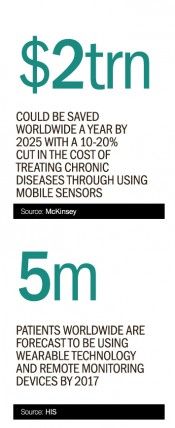Detailed monitoring of disease will enable doctors to understand and treat patients’ conditions with greater success. Some hospitals in the UK, Western Europe and the United States are already in early-stage trials, but others are lagging behind. The coming era of smarter healthcare cannot be ignored, experts say.
More than six million such devices were shipped last year, including those for both medical health and fitness, IDC figures show, and by 2018 over 100 million will be sold annually. The proportion of that figure comprising medical devices has not been quantified, given the early stages of the change, but it is expected to soar.
“Increasingly, even the patients will be asking doctors for wearable devices,” says Karen Taylor, research director at consultancy Deloitte.
Wearables are being piloted in different settings to help patients with Parkinson’s disease, diabetes, heart conditions, high blood pressure and other illnesses, as well as to help the elderly live longer, independent lives at home.
The technology could also provide £6.5 billion in annual NHS savings, according to PA Consulting Group, from reduced appointments and hospital stays. NHS Scotland has made substantial investments in remote healthcare and is thought to be a likely candidate for the earliest adoption.
TECHNOLOGY TRANSFORMATION
Smart watches lead the way, because of their ability to track movement, posture and gait. Most recently, Back to the Future actor Michael J. Fox announced that his Parkinson’s foundation is working with Intel to supply patients with the devices.
Todd Sherer, chief executive at The Michael J. Fox Foundation for Parkinson’s Research, describes the illness as a “24/7 condition”, adding that wearable systems “provide objective data on the continuous lived experience”. Big data analysis of the results improves treatment and research.
There is also a “huge potential” for tailored smart watches and other wearables to help with mental health by tracking movement and environmental interaction, notes Silvia Piai, research manager at IDC Health Insights.
The elderly can equally benefit, particularly from smart watches and smart clothing, which can measure heart rate, temperature, posture, movement and other factors. Dr James Amor, a research fellow at the University of Warwick, says activity-monitoring allows families and carers to see the elderly person’s health and routine, and brings “higher levels of confidence to the user, enabling them to live in their own home for longer”.
Gadgets traditionally aimed at fitness, such as Fitbit wristbands, and watches by Polar and Samsung, plus the new Apple Watch, could soon contain much more advanced healthcare and disease management technology.
Wearables are being piloted to help patients with Parkinson’s disease, diabetes, heart conditions, high blood pressure and other illnesses
Google itself is working with pharmaceutical business Novartis to create smart contact lenses for diabetes patients. The prototype lenses, equipped with wafer thin microcircuits, measure insulin levels on the eyeball, and alert patients’ mobile phones when action is needed. Novartis chief executive Joe Jimenez says wearable tech will increasingly “manage human diseases”.
Pharmaceutical firms are keen to effect this change because they face declining revenue streams. “These companies have a real issue around the lack of blockbuster pills,” explains Ms Piai. “Disease-management technology is becoming a focus.”
Technology companies, such as Proteus, are working on stomach juice-powered, ingestible radio-frequency identification (RFID)-equipped pills, which transmit messages when a tablet has been taken. A spokesperson at the company says the tablets help doctors “gain insight into patient behaviour between visits”. Other companies are working on smart skin patches that can monitor vital signs and even release drugs.
INVESTING IN CHANGE
The treatment and cost benefits cannot be overlooked by healthcare providers, but they need to take several important steps.
Wearable healthcare take-up in the UK lags behind other mature markets. Deloitte’s Ms Taylor says that in the US, where people are paying for their healthcare or insurance, “there is a direct financial incentive to do what it takes to monitor your own health better”.
Hospitals may need to help patients overcome concerns around costs and data security through clear communication and even by prescribing some devices.
Another way round these issues is to provide financial incentives and some healthcare settings are considering rewarding patients for using the devices – a move funded by the reduction in costs from better treatment. Massimiliano Claps, research director at IDC Health Insights, says: “Look at the long-term bill – spending on the devices makes disease management much more affordable.”
There is a more serious threat to patients if they do not use the devices to remain healthy, particularly in markets without state-funded healthcare. “Imagine a scenario in which insurance companies decline to provide cover,” Ms Taylor warns.
Patients’ adherence to using the technology is a further concern. Mr Claps says: “We often find patients stick with the device for a month or two and then usage tails off.” Again, communication and incentives are vital.
The industry must work to overcome technological issues, too, and the most serious is the proprietary nature of many systems. Mr Claps says that some of the fitness device makers, such as Fitbit, Samsung and Apple, see the potential in the healthcare market and may consider making their systems more open for specific purposes.
A technological transformation is taking place, and hospitals, clinics and doctors will need to work with patients and technology providers to move with the change. While wearables will not replace care or clinical judgment, Ms Taylor concludes, they “support staff to work completely differently and really help patients manage their condition”.

